
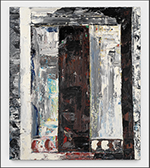

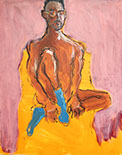

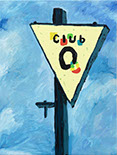
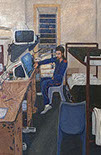
Lonnie Holley: Inside and Outside
at Knoxville’s Big Ears and Gallery 1010
by Sean Roberts
If not entirely discredited, the moniker of “outsider art” has found itself embattled over the last two decades.1 Labels and distinctions like “self-taught” and “folk art” persist, even within the curatorial practices of flagship institutions like the National Gallery of Art. More productively, art spaces like Chicago’s Intuit: The Center for Outsider and Intuitive Art unapologetically embrace these terms as empowering and community building. Both Alabama native Lonnie Holley and writers on his art still rely upon the association of his practice with the outsider trope of “Shamanism.” Holley’s insistence that his first sculpture was a tombstone carved in 1979 for two of his nieces who died in a house fire is likewise an oft-repeated, harrowing, and ultimately effective mythology of this art’s muse.2 Slowly but surely though, Holley, like many artists of his generation, has shed the trappings of the outsider. His paintings and sculptures can be found today in many of the most significant public collections in the U.S. including MoMA and the Metropolitan Museum of Art, to say nothing of his Blue-Chip gallery representation by worldwide giants Blum and Poe, the firm that dubiously brought the world Kanye West’s Famous exhibition at their Los Angeles location in 2016.3
Holley is an integral part of a group of practitioners who challenged and displaced, yet sometimes still embrace, the outsider label of contemporary visual arts. When he decided at the age of sixty-two to try his hand at recording and performing as a musician for the first time, he found himself flagged indelibly, however, with that questionable but nonetheless convenient moniker. Within the less professionalized, and often more dynamic world of music journalism, Holley’s identity as an outsider has persisted and even thrived in proportion to his ever-greater visibility in art galleries over the last several years. To cite but one of dozens of examples, National Public Radio’s 2015 feature on his first album carried the titled “Self-Made Man.”4 Here, Holley is in good company. Such identities are embraced by a bewildering range of music world figures from so-called “outlaw country” music. Consider Eric Church’s decision to name what would become his most commercially successful album The Outsiders—or the geographic outsider chip on the shoulder of emerging non-coastal hip hop crews like those associated with Buffalo’s Griselda Records. Such non-credentialing is probably inevitable in a field that privileges the self-taught and in which very few artists received professional training. Those who do admit credentials must soft-pedal their institutional backgrounds. Betty Who, seen dancing and lip syncing to her brand of electropop atop a float at last year’s Macy’s Thanksgiving Day parade, for example, is a Berklee College of Music alumna. Even Taylor Swift insists, amid what is perhaps the most profitable world tour in industry history, that she is, in fact, the “Anti-Hero,” (the title of her most recent #1 single).
This too-easy dubbing of Holley as an outsider in popular music is ironic. If many commercial musicians must strive to establish such outsider cred, Holley instead has spent decades building a hard-earned opposite central place within contemporary art. Moreover, his output as a music maker often unapologetically embraces insiders. His albums have been produced by and co-written with Jacknife Lee. An industry fixture, Lee is best known for his work with marquis insiders like U2, Missy Elliot, and Eminem. That level of star power is particularly brought to bear on Holley’s 2023 album Oh Me Oh My with its inclusion of indie stalwarts like Michael Stipe, Sharon Van Etten, and even Swift collaborator Bon Iver.5
The distinctive inside and outside mash of Holley’s practices, fluid personas, and critical reception, were on full display for attendees of Knoxville’s Big Ears festival on March 30, 2023. On the one hand, Holley’s works in painting and sculpture felt comfortably at home inside the University of Tennessee’s downtown exhibition space, Gallery 1010. Yet, on the other hand, as a headlining musician, Holley played a key role in the festival itself, a gathering whose organizers have defined as a big tent venue featuring first and foremost new genre-bending and breaking music. Not unlike Holley though, the Big Ears festival finds itself at a crossroads between the inside and outside. Jazz, noise, and the catchall “experimental” often draw upon an inside but aging listener base, while forms of hip-hop, once positioned outside that genre’s mainstream, are gathering previously unimagined commercial and critical success. To give but one example, Billy Woods, an American rapper who took to one of Big Ears’ stages after midnight on Friday, now garners the sort of praise once bestowed upon Dylan, with a vocal faction of the internet commentariat dubbing him America’s greatest living poet.6 Experimentation, fusion, purposely adopted outsideness, all sit at the core of a festival increasingly representative of what critics call the “prestige” wing of Indie, which might reasonably be dubbed Blue Chip Indie. Without a hint of irony, the weekend’s most expensive, all-access tickets are called “Sonic Explorer” passes.7
University of Tennessee’s Gallery 1010 occupies a modest ground floor space within a renovated brick building, on a block of Gay Street where historic industrial spaces are rapidly giving way to luxury apartments, as is happening in much of Old City. For one weekend each March, Gay Street becomes the main artery for Big Ears. Within the white cube of the gallery, visitors encountered twelve of Holley’s paintings and three sculptures.8 The paintings were provided with plenty of breathing room on the walls, and the sculptures set upon the hardwood floors basked in sunlight that streamed through the gallery’s floor to ceiling windows. These were accompanied by a single LCD screen playing music videos for three of Holley’s best-known works as a musician—I Snuck Off a Slave Ship, A Little Too Far (Mistreating Love), and I Woke Up.... The impression was that of a representative selection of recent work by an artist today at home in flagship East and West coast galleries, and part of a now significantly expanded canon of American modernism.
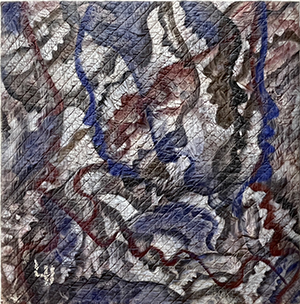
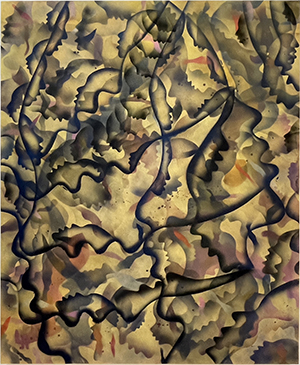
Lonnie Holley (Left), Fresh Out of the Fields, 2023, acrylic, gesso, and spray paint on canvas, 60 1/8 x 48 ¼ x 2 inches. ©Lonnie Holley/Artists Rights Society (ARS), Courtesy of Gallery 1010. (Right) Freedom in the Cemetery, 2022, acrylic, gesso and oil stick on quilt over wood, 48 3/8 x 48 7/8 x 2 inches. ©Lonnie Holley/Artists Rights Society (ARS), Courtesy of Gallery 1010. Photos by the author.
The paintings were a highly unified group completed in the last two years. Each of the works relied upon layered spray paint to create partially transparent silhouettes, alternately legible as faces, and dissolving into pure pattern as the viewer stood in front them. This optical irresolution, an effect the artist has related to the perspectival play of Renaissance painting, was most effective in the largest of these works. Several more modestly scaled examples instead enticed the viewer to closer visual inspection, and to a consideration of the textural play between spray paint, canvas or paper, and acrylic. The palette varied from concrete shades of gray to umbers and muted primaries. The overall effect of these paintings, with their translucent facets of color, could not help but invoke the high-modernist planes of Aaron Douglas’s murals, perhaps especially so here, in that artist’s adoptive home of Tennessee. The most ambitious of Holley’s paintings on display, Freedom in the Cemetery bridged the gap between the artist’s two- and three-dimensional approaches, viscerally exploring texture by combining layered spray paint with more tactile acrylic, gesso, and oil stick on a quilt support. The result is a shimmering interplay of red, blue, black, and brown; an uneasy but effective combination of the iridescent with the worn, weathered, and smudged.
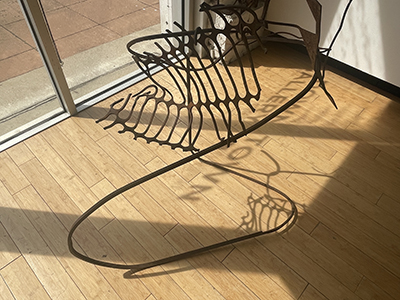
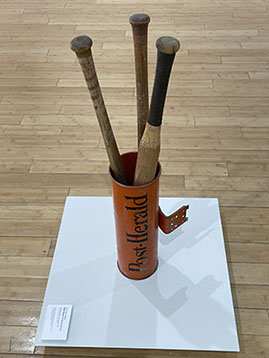
Lonnie Holley (Left), Bad News in Birmingham, 2021, painted mailbox and baseball bats, 22 1/2 x 30 1/8 inches. ©Lonnie Holley/Artists Rights Society (ARS), Courtesy of Gallery 1010. (Right) No Time to Recline (Honoring the Steel Man), 2007-2008, bent steel, 51 x 41 x 34 inches. ©Lonnie Holley/Artists Rights Society (ARS), Courtesy of Gallery 1010. Photos by the author.
This quilt, emblazoned with overlapping and interlocked faces, forcefully called upon vernacular traditions, rural cultural production, and the long memory of Black cultural experience in America. Holley’s 2018 sculpture Bad News in Birmingham, is composed of three wooden baseball bats within a Birmingham Post-Herald branded mailbox. These found objects, what the artist calls “cast-offs,” stands as a reminder both of the now-Atlanta-based artist’s birthplace and what might be any of a dispiriting host of “bad news” that plagued that city’s Black population from slavery through the last century. The specificity of experiences of the Black South gave way, in other works, to an iconography of a more universalized working man. The linear steel armature No Time to Recline (Honoring the Steel Man) of 2007–2008 was positioned near the gallery’s front window. There it cast an oversized, skeletal, and strangely anthropomorphic reflection upon the floor. If the absent- presence of the “boss” hangs over No Time to Recline, it is, instead, that of the overseer that lurks in the background of Fresh out of the Fields. Here the dense overlay of silhouettes that characterize these paintings coalesces into a seeming memorial to the anonymity of the Black faces and lives that grew America’s crops, first under slavery, and later in the Jim Crow South. The pivotal, historical differences separating labor and capital for Black and White Americans suffuse Holley’s visual practice, dovetailing with several of the most urgent and confrontational pieces on his music album Oh Me Oh My. The driving blues-rock of “Mount Meigs” draws upon Holley’s experiences as a teenager at the sinisterly euphemistic “Industrial School for Negro Children” in that Alabama community. That juvenile detention center is now infamous for its continuation of Jim Crow era forced labor practices well into the second half of the twentieth century. So too, the song “Better Get That Crop in Soon” slides ambiguously between narratives of plantation slavery and the persistence of exploitative Black agricultural work in the modern South.
%20rgbjpg.jpg?crc=4018388375)
Lonnie Holley, Fresh Out of the Fields (detail), 2023, acrylic, gesso, and spray paint on canvas,
60 1/8 x 48 ¼ x 2 inches. ©Lonnie Holley/Artists Rights Society (ARS), Courtesy of Gallery 1010.
Photo by the author.
On Thursday evening, Holley stood some three blocks east of Gallery 1010, on the stage of the Mill and Mine, a warehouse-like modern event space, whose brick walls and exposed ceiling were purpose-designed to evoke the industrial spaces with which it shares real estate. Though a smattering of less-anticipated performances had been underway since mid-afternoon, it was Holley’s set, in one of the Big Ear’s prime locations, that truly kicked off the festival’s opening night. A bit surprisingly, the artist performed none of the “hits,” whose videos were included in the exhibition. Indeed, little was recognizable here from Holley’s five studio albums. Instead the crowd was treated to a largely improvised and—by necessity—little rehearsed set with Cleveland’s Mourning.A.BlackStar, an ensemble who describe themselves as “multi-generational, gender and genre non-conforming amalgam of Black Culture dedicated to servicing the stories and songs of the apocalyptic diaspora.”9 Addressing the audience early in the performance, Holley explained, or perhaps boasted, “We ain’t practiced none of this. I ain’t gonna lie to you. We’re bringing it to you raw; straight out the straw.” This was true in spirit, notwithstanding that the group Mourning.A.BlackStar and Holley are close collaborators who have performed together intermittently over the past several years. Like his albums, these songs set Holley’s weathered and authoritative voice upon a core braiding of jazz, rock, and blues patterns. The multi-vocal arrangements and harmonies, for which the band is known, amplified however the gospel and traditional spiritual elements present in Holley’s music. The result was not so much one of the shaman, but of the secular preacher, of a vernacular revival. Near the end of the hour-long set, Holley and his collaborators were joined by fellow poet, Moor Mother, for a more structured rendition of “I am a Part of the Wonder,” a track on which she features on the Oh Me Oh My album.
Holley has long used “Thumbs up for Mother Universe” as a kind of mantra at his shows. Those words, and the accompanying gesture, are known and repeated by his fans, and taught easily to newcomers. Indeed, the simple phrase is so connected with the artist that George King used it as the title for his 2021 biographical film. As Holley and the dozen-odd musicians around him on stage ended their set on Thursday night, the crowd was all thumbs, so to speak. If Holley is a preacher, his gospel is one of the potential for shared human experience and the hope it might provide. That message of universal hope was presented in Gallery 1010 by the 2018 work Setting Liberty Free (Bound for Freedom) an assemblage that placed a small, souvenir Statue of Liberty within an antique bird cage, it’s door conspicuously thrown open. Such optimism suffuses as
well the memento mori and call to action of Oh Me Oh My’s “We All Have but a Little While.” When I passed Holley walking on Gay Street early Saturday afternoon, without much thought, I gave him the thumbs up and the artist, after just a split second of hesitation, dutifully and graciously returned my gesture. This momentary exchange though—and what I rightly or wrongly perceived as the briefest apprehension—left me trying to put my finger on a feeling that had lingered over Thursday night’s performance. A bit of tiredness might well be in order, of course, for a 72-year-old man who, it seems, never stops working. Holley not only performed on Thursday night, but also gave a range of shows throughout the weekend. He joined other artists on stage and put together an ad hoc backing group dubbed as his “All Stars” for a Saturday gig. In addition to these Big Ears sets, Holley took part in educational outreach to Knoxville public schools and held a workshop for MFA candidates at the University of Tennessee’s School of Art.
Still, might not just a little of this weariness be a reasonable response to the unacknowledged burdens of preaching positivity amidst increasingly polarized red state politics? Might not some friction arise from telling stories of the slave ship, night after night, within the sanitized, and overwhelmingly White spaces reserved for festivals and prestigious, indie rock music? Whether in the gallery or in his recordings, Holley can hardly be accused of shilling toxic positivity. “I woke up in a fucked-up America” is perhaps his second best-known phrase, even though its full statement is elided in the song’s “I Woke Up” title itself. So too, a viewer might well glance from the uncaged Statue of Liberty and catch sight of one of the many undeniably confrontational, even disturbing images, like a caricatured Black lawn jockey draped with a frayed noose, which populate that song’s video in the gallery.
As many of America’s most successful hip hop acts have long known, it is certainly possible to play for increasingly White audiences, and such recognition has engendered a range of performative responses. That range was, in some small way, on display in the varied strategies employed by artists throughout the Big Ears Festival. This event was, after all, an event headlined by many artists of color for the decidedly, though hardly exclusively, White audience. Later Thursday evening, Moor Mother performed as part of her duo 700 Bliss in Jackson Terminal. If she reassured Holley’s listeners that we were all “part of the wonder,” then those who stuck around for the late show were met with a decided shift in tone. The claxons and screeches of DJ Haram’s soundboard, a tangled rat’s nest of wires and effects pedals, overwhelmed the relatively intimate space, open to the public and used throughout the festival to sell merch. Few beers and even fewer shirts seemed to be sold during 700 Bliss’ set, and Moor Mother’s jibes at the present state of politics in Tennessee hung in the air along with the unspoken, but unshakeable sense that, just maybe, the universe was not returning all of those thumbs up as the night turned to early morning.
Sean Roberts is Senior Lecturer at the University of Tennessee and former director of Virginia Commonwealth University’s art history program in Doha, Qatar. Sean’s essays on the art of Europe and the Islamic lands, the cultural history of maps, and the place of printmaking in the histories of art and technology have appeared in journals including Renaissance Studies, Print Quarterly, and, most recently, Material Culture Review. His first book, Printing a Mediterranean World published Harvard University Press was called a “future classic on the subject” by the Times Literary Supplement. His most recent co-edited book The Environment and Ecology in Islamic Art and Culture appeared this June with Yale University Press.
Footnotes
1. See especially Lisa Slominski, Nonconformers: A New History of Self-Taught Artists (New Haven and London: Yale University press, 2022).
2. See for example, Sean O’Hagan, “’It’s Like One Continuous Song Pours Out of Him’: Meet the Shaman-like Artists-Musician Lonnie Holley,” The Guardian May 1, 2022: https://www.theguardian.com/artanddesign/2022/may/01/lonnie-holley-art-the-growth-of-communication-the-edge-of-what Accessed 6/7/2023 and Rachel White, “Lonnie Holley and the Geologies of Alabama,” blogpost for the Smithsonian, May 19, 2018: https://www.aaa.si.edu/blog/2018/03/lonnie-holley-and-the-geologies-of-alabama. Accessed 6/8/2023.
3. https://www.blumandpoe.com/exhibitions/kanye_west. Accessed 6/5/2023.
4. R.J. Smith “Lonnie Holley: Self-Made Man,” for NPR https://www.npr.org/sections/therecord/2013/10/31/242114835/lonnie-holley-self-made-man. Accessed 6/5/2023.
5. Zach Schonfeld, Pitchfork review of Oh Me Oh My: https://pitchfork.com/reviews/albums/Lonnie-holley-oh-me-oh-my/. Accessed 6/5/2023.
6. Tom Breihan, Stereogum Album of the Week column for billy woods & Kenny Segal, Maps May 2, 2023: https://www.stereogum.com/2222254/billy-woods-kenny-segal-maps/reviews/album-of-the-week/. Accessed 6/14/2023.
7. https://bigearsfestival.org/passes/. Accessed 6/13/2023.
8. Gallery 1010, Current and Past Exhibitions: https://downtown.utk.edu/past-exhibitions/. Accessed 6/13/2023
9. https://mourningablkstar.com/. Accessed 6/5/2023.
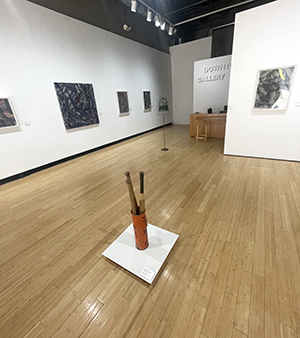
Installation view of “Lonnie Holley March 3-April 2, 2023: In Collaboration with Big Ears,” University of Tennessee School of Art, Gallery 1010. Photo by the author.
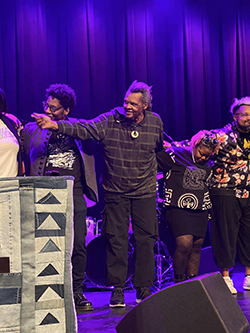
Holley and members of Mourning.A.BlkStar take a bow following their set at the Mill and Mine in Knoxville Tennessee on March 30, 2023.
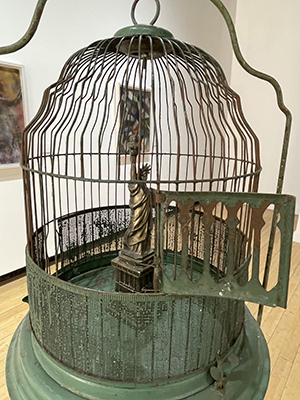
Lonnie Holley, Setting Liberty Free (Bound for Feedom), 2018, antique bird cage and souvenir Statue of Liberty, 65 x 15 x 14 inches. ©Lonnie Holley/Artists Rights Society (ARS), Courtesy of Gallery 1010. Photo by the author.
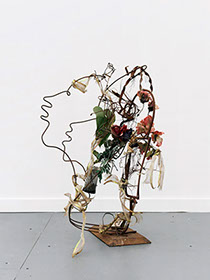
Lonnie Holley, Memorial at Friendship Church, 2006. Metal, found debris, plastic flowers and ribbon, 38 x 31 x 27 inches. Courtesy of the artists and James Fuentes Gallery.
Editor's Note: This piece was featured at the EXPO CHICAGO 2023 at the James Fuentes Gallery booth.